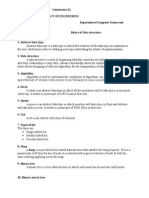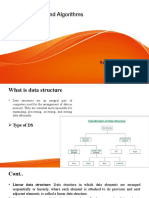Here are concise explanations for your queries:
1. Difference between Linear & Non-Linear Data Structures
Linear Data Structure: Data is organized sequentially (e.g., Arrays, Stacks, Queues).
Non-Linear Data Structure: Data is organized hierarchically or non-linearly (e.g., Trees, Graphs).
2. Push and Pop Algorithms (Stack Operations)
Push (Insert): Add an element to the top of the stack.
Algorithm:
1. If TOP == MAX - 1, then Overflow.
2. Else, TOP = TOP + 1; STACK[TOP] = Element.
Pop (Remove): Remove the top element from the stack.
Algorithm:
1. If TOP == -1, then Underflow.
2. Else, Element = STACK[TOP]; TOP = TOP - 1.
3. Overflow and Underflow Situations
Overflow: Occurs when adding an element exceeds the structure's capacity (e.g., pushing into a full stack).
Underflow: Occurs when trying to remove an element from an empty structure (e.g., popping an empty stack).
4. Difference Between Stack and Array
Stack: Follows LIFO (Last In, First Out). Operations are restricted to one end (top).
Array: Elements are indexed; supports random access. No restrictions on operations.
5. Circular Queue and Its Advantages Over Linear Queue
Circular Queue: End of the queue connects to the front, making it circular.
Advantages: Utilizes space efficiently, avoids "queue full" issues in a partially empty array.
6. Priority Queue and Dequeue
Priority Queue: Elements are dequeued based on priority rather than order of arrival.
Dequeue (Double-Ended Queue): Elements can be added/removed from both ends.
7. Postfix Evaluation
Postfix notation eliminates the need for parentheses. Use a stack to evaluate.
Example: 3 4 + evaluates as (3 + 4).
8. Infix to Postfix & Prefix Conversion
Infix: Operators between operands (e.g., A + B).
Postfix: Operators after operands (e.g., AB+).
Prefix: Operators before operands (e.g., +AB).
9. Singly Linked List & Advantages
Singly Linked List: Nodes contain data and a pointer to the next node.
Advantages: Dynamic size, efficient insertion/deletion.
10. Tower of Hanoi (Short Note)
A puzzle involving moving disks from one rod to another, following these rules:
� 1. Only one disk moved at a time.
2. A larger disk cannot be placed on a smaller disk.
11. Algorithm to Insert a Node at Beginning, Middle, and Last
Beginning:
1. Create a new node.
2. Point new node’s next to the head.
3. Update head to the new node.
Middle:
1. Traverse to the desired position.
2. Adjust pointers to insert the new node.
Last:
1. Traverse to the last node.
2. Point last node's next to the new node.
12. Binary Tree
A tree where each node has at most two children: left and right.
13. Strictly, Full, & Complete Binary Trees
Strictly Binary Tree: Each node has 0 or 2 children.
Full Binary Tree: All levels are completely filled except possibly the last.
Complete Binary Tree: All levels are filled, and the last level has nodes as far left as possible.
13. Binary Tree Traversals
Given a binary tree:
A
/ \
B C
/ \ \
D E F
In-order (LNR): Traverse left subtree, root, right subtree.
Output: D, B, E, A, C, F
Pre-order (NLR): Traverse root, left subtree, right subtree.
Output: A, B, D, E, C, F
Post-order (LRN): Traverse left subtree, right subtree, root.
Output: D, E, B, F, C, A
14. Short Note on Abstract Data Type (ADT)
An ADT is a data structure defined by its behavior from the user's perspective.
Includes operations but not implementation details.
Example: Stack ADT with operations like Push(), Pop(), IsEmpty().
15. Define B-Tree
A B-Tree is a self-balancing search tree where nodes can have multiple children.
Ensures balanced height.
Used in databases and file systems.
Properties:
Each node contains t-1 to 2t-1 keys, where t is the order.
Leaves are at the same level.
16. Construct an AVL Tree
Steps to construct:
� 1. Insert nodes while maintaining a balanced height difference of ≤ 1 between subtrees.
2. Perform rotations (LL, RR, LR, RL) as needed to balance.
Example: Insert 10, 20, 30.
Insert 10.
Insert 20. No imbalance.
Insert 30. Imbalance at root (LL rotation).
Resulting tree:
20
/ \
10 30
17. Construct a Binary Tree Given In-order & Pre-order Traversals
Given:
In-order: D, B, E, A, C, F
Pre-order: A, B, D, E, C, F
Steps:
1. First element of pre-order is root (A).
2. Split in-order into left (D, B, E) and right (C, F) subtrees based on root.
3. Recursively construct subtrees.
Constructed tree:
A
/ \
B C
/ \ \
D E F
18. Polynomial Representation Using Linked List
A polynomial can be represented as a linked list where each node contains:
Coefficient
Exponent
Pointer to the next term
2
Example: 3𝑥 + 4𝑥 + 5
Node1: Coefficient = 3, Exponent = 2 → Node2: Coefficient = 4, Exponent = 1 → Node3: Coefficient = 5,
Operations:
Addition/Subtraction: Traverse, match exponents, and adjust coefficients.
Multiplication: Multiply coefficients, add exponents, and combine terms.
Let me know if you want detailed construction examples or algorithms!
























































































